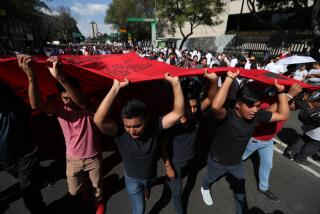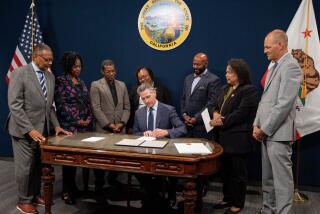Canada natives get apology
OTTAWA — Canadian Prime Minister Stephen Harper apologized Wednesday to the nation’s native people for “a sad chapter in our history,” acknowledging the physical abuses and cultural damage they suffered during a century of forced assimilation at residential schools.
“Today, we recognize that this policy of assimilation was wrong, has caused great harm, and has no place in our country,” he said to applause.
A group of 11 aboriginal leaders and former residential school students sat before Harper in a circle in the House of Commons, some weeping as the prime minister delivered the government’s first formal apology to them.
In the crowded, expectant chamber, Harper bowed his head as he read a carefully crafted speech, asking for forgiveness for separating children from their families and cultures, exposing the students to abuse, and sowing the seeds for generations of problems.
Over more than a century, about 150,000 native Canadian children were sent to boarding schools run by churches and the government to “civilize and Christianize” them.
Expressions of native heritage were outlawed. Many children suffered sexual and psychological abuse and grew up with neither traditional roots nor mainstream footing, their ties to family and community unraveled.
“The government now recognizes that the consequences of the Indian residential schools policy were profoundly negative and that this policy has had a lasting and damaging impact on aboriginal culture, heritage and language,” Harper said.
The apology was billed by the government as a chance to redress a dark chapter in Canadian history and to move forward in reconciliation.
But the hours before the landmark statement were marked by wrangling over whether native leaders were adequately consulted about the content, and anger that they would not be allowed to respond in the House of Commons. Just before Harper’s speech, opposition leaders led a successful motion to allow aboriginal representatives to reply in the chamber.
Assembly of First Nations National Chief Phil Fontaine, wearing a feather headdress, took the floor to declare that the occasion “testifies nothing less than the accomplishment of the impossible.” In 1990, he was one of the first to come forward with his story of abuse and push for an apology.
“For the generation that will follow us, we bear witness today. . . . Never again will this House consider us the Indian problem just for being who we are,” he said, as tribal members cheered and beat a drum in the gallery. “Finally, we heard Canada say it is sorry.”
Some survivors, as the former schoolchildren are widely called, said the apology came only grudgingly under intense pressure from native groups, and must be matched by action. But it is widely recognized as a significant step for a government that had previously sought to limit its responsibility for the harm caused by its assimilation policy.
Several churches offered apologies in the late 1980s and 1990s, and the government’s head of Indian and Northern Affairs made a statement of reconciliation in 1998. A lawsuit settled in 2006 created a $1.9-billion compensation fund, and an independent Truth and Reconciliation Commission was launched June 1.
But Wednesday’s statement is the government’s first formal expression of responsibility and remorse for the forced assimilation program.
Elijah Harper, 49, a Cree leader from Manitoba, said the prime minister’s speech allowed his people to embark on the road of reconciliation.
“From a spiritual point of view, what he has done is release the bonds that have held us from being able to forgive,” Harper said.
Analysts say that the next step for the government is to settle outstanding land claims with aboriginal groups, and to refocus policies to alleviate poverty and improve education among First Nations.
“Even if you solved this, there are a number of issues still facing aboriginal people,” said James Miller, a University of Saskatchewan expert on the residential schools.
An editorial in Toronto’s National Post newspaper offered one of the few voices defending any part of the residential school system.
“Being honest with history also means acknowledging that the residential schools did provide the education and training that opened new horizons to their graduates,” it said. “Many students were saved from serious childhood illnesses, or even death, because of their access to health care. To recognize what was wrong does not require ignoring what was right.”
But for most of the former residential school students, the focus will be on fixing those wrongs.
Many former students gathered across the country, and at Ottawa’s House of Commons, where television screens were set up on the lawn for the crowds.
Counselors were mobilized to help people deal with emotional memories triggered by the event.
Geraldine Maness-Robertson, 72, a Chippewa from Aamjiwnaang First Nation, said her six years at an Anglican school were a “horrific experience,” and her hands were often whipped with a razor strap to break her spirit.
“When I left, I was so full of rage and anger and hatred,” she said. “Today’s apology was so helpful, it hit all the areas of hurt. I have spent my whole life reconciling, and I turned a page today.”
Canada got it right, said Sammy Toineeta, a founder of the Boarding School Healing Project, a national coalition seeking justice for similar abuses and loss of culture in Native American boarding schools in the United States.
“An apology does not carry much weight unless there is something behind it. In Canada, they got a certain amount of land and money, and then the apology,” said Toineeta, a Lakota who attended a boarding school in Rosebud, S.D. “That’s the way to do it. Action first and then words.”
--
Special correspondent Guly reported from Ottawa and Times staff writer Farley from New York.
More to Read
Sign up for Essential California
The most important California stories and recommendations in your inbox every morning.
You may occasionally receive promotional content from the Los Angeles Times.










